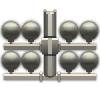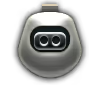



In March 1995, the Swedish Chief of Army Command, Åke Sagrén, announced the need for a dedicated attack helicopter platform, citing the changing nature of modern warfare and the HKP9A helicopter's inability to satisfy the Army's requirements. Two helicopters, the Boeing AH-64 Apache and the Mil Mi-28A Havoc, were chosen as final candidates after the field of potential helicopters was narrowed to two. These helicopters were flown by foreign pilots while Swedish crew served as operators/gunners. The former was regarded as a complex but effective platform, while the latter was viewed as reliable, easy to control, and less of a burden for maintenance crews. Both passed initial trials successfully, but procurement was cancelled due to budget cuts and a shift in national defence priorities.
The Mi-28A was introduced in Update "Wind of Change". Based on the early production Mi-28A that was trialed by the Swedish army during the 1990s, its loadouts and gunnery equipment are somewhat limited in comparison to the later Mi-28N and Mi-28NM, but it remains very potent in the right hands. Due to its effective rocket loadouts and 30 mm gun, it works best as an early-spawn helicopter, but thanks to its Ataka missiles, it is still capable of long-range combat in the middle to late stages of the game.
| Belt | Belt filling | Armor penetration (mm) at a distance: | |||||
|---|---|---|---|---|---|---|---|
| 10 m | 100 m | 500 m | 1000 m | 1500 m | 2000 m | ||
| AP-T/HEF-I | 65 | 63 | 53 | 44 | 36 | 29 | |
| APDS/AP-T/HEF-I/HEF-I | 82 | 81 | 79 | 75 | 72 | 69 | |
| APDS | 82 | 81 | 79 | 75 | 72 | 69 | |
| HEF-T/AP-T/HEF-I/HEF-I | 65 | 63 | 53 | 44 | 36 | 29 | |
| Name | Weight | Slot | ||||
|---|---|---|---|---|---|---|
| 20 × | 326 kg |  |  |  |  | |
| 5 × | 505 kg |  |  |  |  | |
| 8 × | 391.2 kg |  |  | |||
| 163.8 kg |  |  | ||||







 2 x (50 / 260 / 420) %
2 x (50 / 260 / 420) % 
 2 x 232 %
2 x 232 % 

Flight performance |
|---|
Survivability |
|---|
Weaponry | |
|---|---|